“Digital transformation offers APAC the ability to connect workforces to a global surge in technological advances, entrepreneurship and innovation.”
Asia-Pacific (APAC) economies experience fluctuations in the global economy in unique ways, because each is defined by particular geographic, societal and financial circumstances. However, the accelerated pace of digital transformation and tightening geopolitical tensions have connected the fates of all APAC growth economies to the ubiquitous effects of globalization.
Though APAC economies are projected to experience solid growth of 5.6 percent over the next two years, this optimistic forecast for the region remains prone to serious vulnerabilities.1 The areas of exposure can be organized into four categories: economic, geopolitical, technical and environmental. Let's take a look at each and how they may create challenges for nations poised for growth in the near future.
1. Economic: Debt & Housing
In 2016, APAC surpassed North America as the largest contributor to global debt. In fact, APAC accounted for 35 percent of the world's debt, marking a steady and significant rise since the financial crisis of 2008. This debt makes regional economies susceptible to increased interest rates and a potential default crisis.
Each economy has specific areas of exposure. In China, for example, nonfinancial corporations and household debt are rising, while in Japan, the primary concern is public debt that exposes its sovereign bond market to risks. India is also facing the impact of US$210 billion in spending on nonperforming assets in state banks.
Figure 1: Nonfinancial sector debt as a percentage of GDP across APAC.
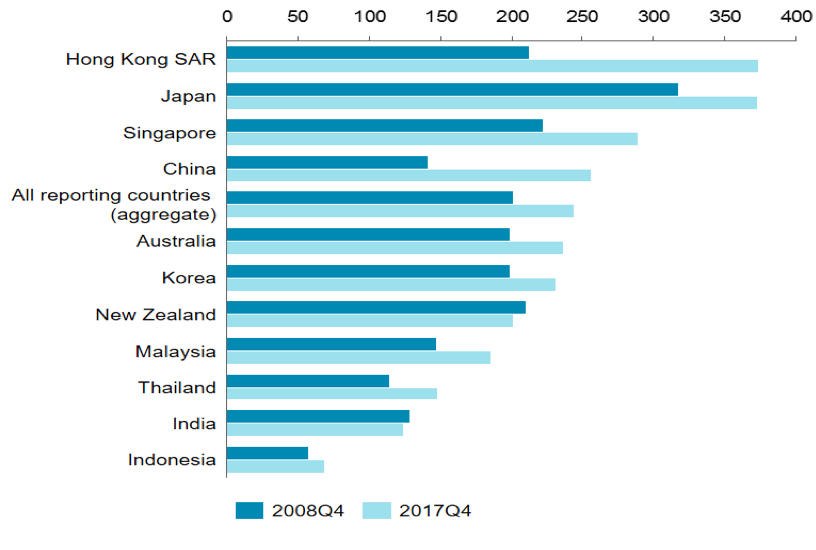
Housing prices across APAC have been growing faster than income since 2010, especially in places like Hong Kong, Australia, New Zealand and India — where families in Mumbai find affordable housing nearly nonexistent. Though the costly housing situation has the region feeling anxious about a looming asset bubble on the verge of popping, each country has unique credit lending mechanisms and household debt numbers that determine their risk levels. These economies must heed lessons learned from the 2008 U.S. housing market crisis, where private households unable to pay their debts contributed to a global economic crisis that continues to haunt the international banking industry.
In fact, Australia currently has one of the world's highest levels of household debt. Considering that Australian bank portfolios are majority grown from mortgage lending — now at levels far surpassing the U.S. housing market just before the 2008 crash — many U.S. and global investors are more inclined to hedge the Australian market.
Figure 2: Compound annual growth rate for real residential property price and GDP per capita for selected countries across APAC, 2010–2017 Housing price data from Bank of International Settlement, GDP per capita data from Economist Intelligence Unit.
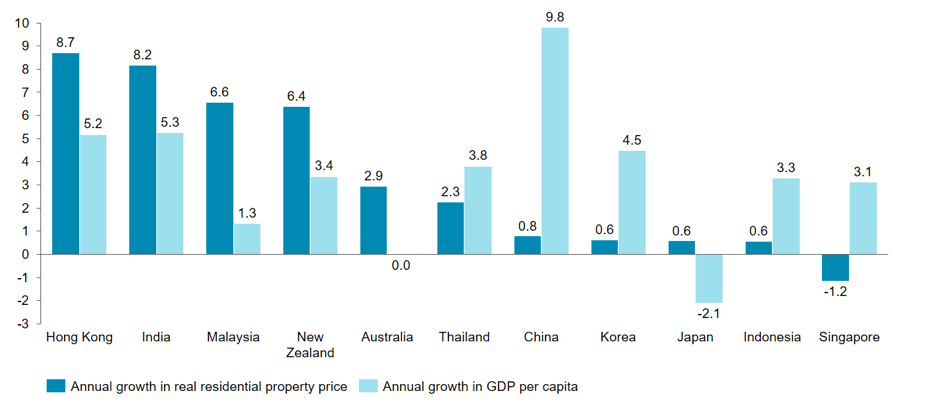
2. Geopolitical: Protectionism & Inequality
In an interconnected global economy, every region is affected by international trade dynamics and tariffs. The escalating trade war between China and the U.S. threatens supply chains across APAC, and a trend toward protectionism could infiltrate the area's closely intertwined network of economies as some countries struggle more than others.
Fast-paced geopolitical developments create uncertainty. That anxiety often compels businesses and policymakers to contract and insulate their economy's exposure to negative consequences. In fact, as China and the U.S. redefine their priorities, nations in APAC are forced to decide where and how they fit into this continuously evolving situation. From Australia to India, APAC economies must navigate the complexities of cooperating and competing with other nations without alienating business partners or sacrificing growth opportunities.
Figure 3: Wealth GINI coefficient in selected countries in APAC, 2012–2017 Data from the Global Wealth Data book (Credit Suisse).
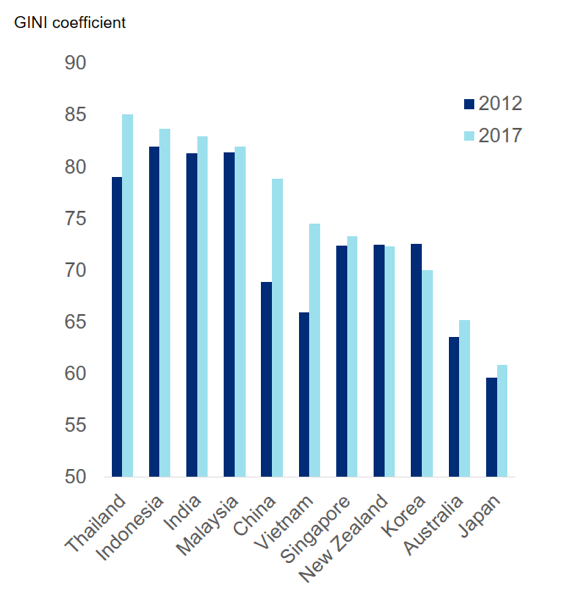
While APAC seeks stability in chaotic geopolitics, many are experiencing seismic demographic shifts internally as a result of global trade and commerce. Access to trade-friendly seaports, modern technology hubs and high-skilled job opportunities has led to the rise of metropolises and megacities. The continued migration of younger generations to urban areas that offer innovative cultures, ideas and infrastructure is marginalizing peripheral and rural communities. This widening disparity between the haves and the have-nots could lead to income and wealth inequality, widespread resentment and civic unrest.
Policymakers are attempting to manage the prevailing attitudes and regulations that shape human capital management in APAC. Josephine Teo, Singapore's Minister of Manpower, recently addressed the need for Singaporeans to travel and work in surrounding countries — asking her fellow Singaporeans to keep an open mind about opportunities in other growth economies in APAC, particularly as Singapore strengthens business ties with China.2
3. Technological: Miracles & Menace
Technology will shape the future of the global economy. Emerging devices and technologies are developing faster than governments can regulate them, and this gap in oversight will create unprecedented opportunities for economic growth, innovation and crime. Technology has helped APAC increase workforce productivity, advance social reforms and champion environmental sustainability. The impact of digital transformation for ASEAN nations is tremendous, especially in e-commerce, where ASEAN nations accounted for 40 percent of global sales in Q1 2017; in Southeast Asia alone, the number of people with access to the internet and all of its possibilities is expected to triple from 200 million to 600 million by 2025.3
While new technologies will result in the loss of some jobs, these same technologies are set to create many new jobs. In fact, many companies building AI systems have found that human employees play an active role in designing and running AI.4 History reveals that innovation leads to job creation. Take the advent of the computer as an example. While the demand for typist-related roles may have decreased, the demand for computer-based work created new jobs related to developing, operating and programming. These gains, however, come with modern challenges, too.
Sophisticated cybercriminals from around the planet will continue to seek and exploit weaknesses in governments, institutions and enterprises of every size. As data and information become as valuable as natural resources, state-on-state cyber-attacks will increase in frequency and complexity. The confluence of alliances between governments and multinational corporations will have life-changing ramifications for populations and their rights to privacy. As different countries adopt different policies regarding human rights and access to personal information, a new generation of cyber-laws will emerge to set protective boundaries and mitigate human fallibility as people become more intertwined with their technologies.
Figure 4: Weighing the benefits of technology against its various risks.
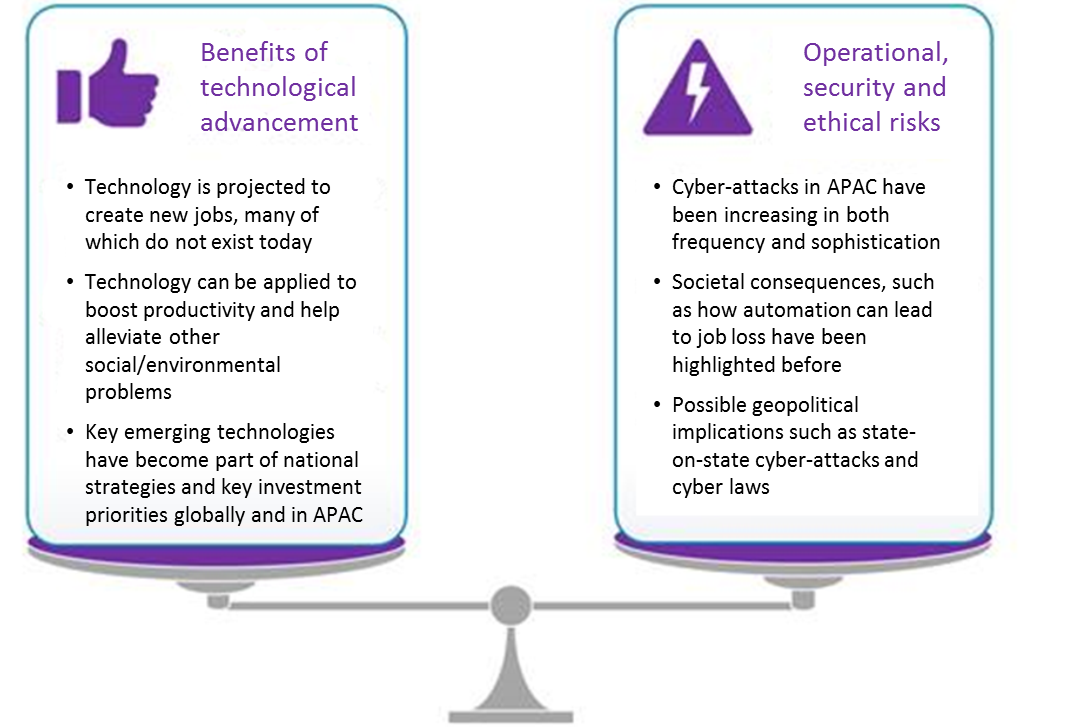
4. Environmental: Natural Disasters & Man-made Solutions
Environmental factors will determine the future economic prospects and overall quality of life for APAC. Geographically, APAC is the most disaster-prone area in the world. Environmental events, such as floods and tropical cyclones, inflict tremendous damage on coastal areas — where most people, infrastructure and institutions are located. The unpredictability of natural disasters often results in the sudden — and sometimes massive — loss of human life, displacement of populations and widespread social and economic disruption.
In the aftermath of such trauma, individuals and communities must navigate their way through emotional grief and destabilized healthcare operations until governments and other agencies can provide relief. APAC must be proactive about implementing integrated policies and systems that can mitigate the devastation natural disasters pose to their people and economies. This is already happening: More mature markets, like Hong Kong, have exponentially increased the ability to align resources and swiftly respond to events, such as hurricanes. As technologies and business interests continue to connect APAC more closely, governments will have to decide what, exactly, their responsibilities are to other nations and the region.
Figure 5: Projected vulnerability changes for Asia and the Pacific.
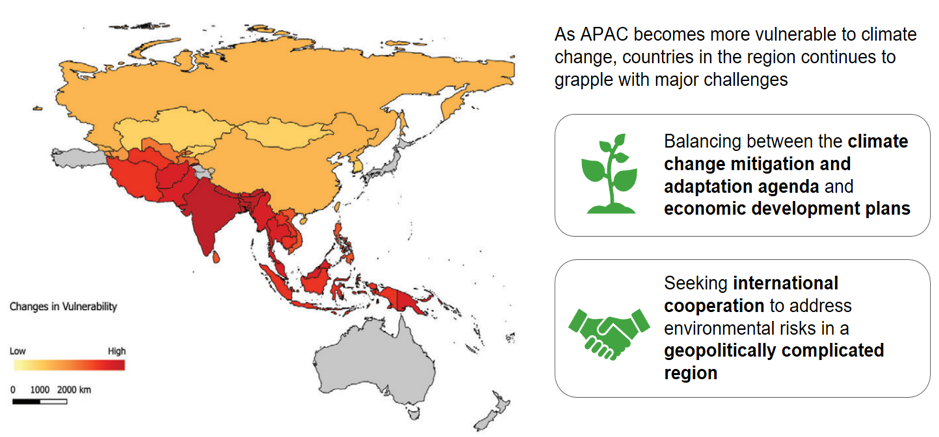
Data from UNESCAP
On a global scale, APAC plays an integral role in curbing harmful emissions and pollutants. Antiquated infrastructure and lax regulations must be replaced with modern technologies and policies. Change, however, can be slow and expensive. Many APAC economies are still dependent on legacy energy resources, such as coal and other fossil fuels. Yet, strong progress has been made on regional and local levels.
China, for instance, has made remarkable progress in implementing green fuel technologies to replace coal and oil and reduce airborne pollutants.5 China's new initiatives to supplant fossil fuels with clean energy resources, such as wind and solar, has led to vastly improved air quality in cities, like Beijing — without negatively impacting the country's economy. In fact, China considers sustainable resources to be the future of energy and is aggressively investing in green businesses, such as high-tech solar panels (two-thirds of the world's solar panels are manufactured in China) and electric vehicles—surpassing even Tesla with a projected 7 million annual sales by 2025.6
APAC, as a region, has also agreed to frameworks and new technologies that promote renewable energy sources to combat air pollution and water scarcity issues that pose a direct and immediate threat. Balancing economic development with progress on climate and sustainability initiatives will be challenging but necessary.
Climate change, as with other challenges in the region, will require a new era of cooperation among APAC nations, governments and workforces. With the withdrawal of the U.S. from the Trans-Pacific Partnership (TPP) in January 2017, APAC was compelled to consider a more regional approach to solving global issues. APAC leaders, however, persevered and, in 2018, signed a revised version of the TPP with commitments from Australia, Brunei, Canada, Chile, Japan, New Zealand, Malaysia, Mexico, Peru, Singapore and Vietnam.
The new agreement, named the Comprehensive and Progressive Agreement for Trans-Pacific Partnership (CPTPP), represents about 14 percent of the global GDP (down from the 40 percent the original TPP represented) and not only details new trade dynamics and oversight regulations among the participating nations but also compliance with mutually agreed-on environmental protection laws. Some of the clauses around intellectual property, arbitration and investment dispute resolution have been left out in the new treaty to allow for continuing reliance on ongoing multilateral collaboration on specific issues and local interventions by individual governments needed in public interest. The new treaty does not regulate movement of workers in the region, and member countries have ensured the interests of their agrarian and services economies are protected.
An increasingly internally focused U.S. may compel APAC to strengthen their ties to each other, opening up more avenues for business opportunities, talent exchange and shared participation in worldwide digital transformation. With most members set to ratify the new treaty, this represents a glowing bastion of free trade amid an increasing protectionist rhetoric elsewhere in the world.
There are many reasons to be optimistic about the future of APAC. Digital transformation offers the economies of APAC unprecedented growth opportunities and the ability to connect workforces to a global surge in technological advances, entrepreneurship and innovation. The pressing need to address environmental concerns and financial headwinds is creating a sense of urgency throughout APAC. The collaborative approach to solving problems bodes well for the future of APAC, as its committed leaders and locally based organisations coordinate their collective strengths to create prosperity throughout the region. As the global economy continues to evolve, APAC is poised to play an increasingly influential role.
Read Marsh & Mclennan's 14 Shades of Risk in Asia-Pacific report to learn more.
1Evolving Risk Concerns in Asia-Pacific:, http://bit.ly/2APQVlZ.
2Lee, Pearl. "Ties with China Multifaceted and Strong: Josephine Teo." The Straits Times, 2 Mar. 2017, www.straitstimes.com/singapore/ties-with-china-multifaceted-and-strong-josephine-teo.
3"Asean the 'next Frontier' for e-Commerce Boom." Bangkok Post. https://www.bangkokpost.com/business/news/1249798/asean-the-next-frontier-for-e-commerce-boom.
4Mims, Christopher. "Without Humans, Artificial Intelligence Is Still Pretty Stupid." The Wall Street Journal,https://www.wsj.com/articles/without-humans-artificial-intelligence-is-still-pretty-stupid-1510488000?mod=article_inline.
5Song, Sha. "Here's How China Is Going Green." World Economic Forum, www.weforum.org/agenda/2018/04/china-is-going-green-here-s-how/.
6Jeff Kearns, Hannah Dormido and Alyssa McDonald. "China's War on Pollution Will Change the World." Bloomberg, www.bloomberg.com/graphics/2018-china-pollution/.











